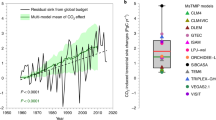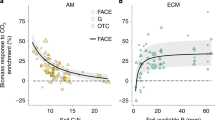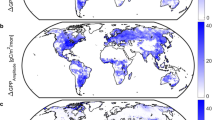Abstract
Carbon dioxide is the main greenhouse gas inducing climate change. Increased global CO2 emissions, estimated at 8.4 Pg C yr−1 at present, have accelerated from 1% yr−1 during 1990–1999 to 2.5% yr−1 during 2000–2009 (ref. 1). The carbon balance of terrestrial ecosystems is the greatest unknown in the global C budget because the actual magnitude, location and causes of terrestrial sinks are uncertain2; estimates of terrestrial C uptake, therefore, are often based on the residuals between direct measurements of the atmospheric sink and well-constrained models of ocean uptake of CO2 (ref. 3). Here we report significant terrestrial C accumulation caused by CO2 enhancement to net ecosystem productivity in an intact, undisturbed arid ecosystem4,5,6,7,8 following ten years of exposure to elevated atmospheric CO2. Results provide direct evidence that CO2 fertilization substantially increases ecosystem C storage and that arid ecosystems are significant, previously unrecognized, sinks for atmospheric CO2 that must be accounted for in efforts to constrain terrestrial and global C cycles.
This is a preview of subscription content, access via your institution
Access options
Subscribe to this journal
Receive 12 print issues and online access
$209.00 per year
only $17.42 per issue
Buy this article
- Purchase on Springer Link
- Instant access to full article PDF
Prices may be subject to local taxes which are calculated during checkout


Similar content being viewed by others
References
Friedlingstein, P. et al. Update on CO2 emissions. Nature Geosci. 3, 811–812 (2010).
Ballantyne, A. P., Alden, C. B., Miller, J. B., Tans, P. P. & White, J. W. C. Increase in observed net carbon dioxide uptake by land and oceans during the past 50 years. Nature 488, 70–72 (2012).
Houghton, R. A., Hall, F. & Goetz, S. J. Importance of biomass in the global carbon cycle. J. Geophys. Res. 114, G00E03 (2009).
Billings, S. A., Schaeffer, S. M. & Evans, R. D. Trace N gas losses and N mineralization in Mojave Desert soils exposed to elevated CO2 . Soil Biol. Biochem. 34, 1777–1784 (2002).
Housman, D. C. et al. Increases in desert shrub productivity under elevated carbon dioxide vary with water availability. Ecosystems 9, 374–385 (2006).
Ferguson, S. D. & Nowak, R. S. Transitory effects of elevated atmospheric CO2 on fine root dynamics in an arid ecosystem do not increase long-term soil carbon input from fine root litter. New Phytol. 190, 953–967 (2011).
Billings, S. A., Schaeffer, S. M. & Evans, R. D. Soil microbial activity and N availability with elevated CO2 in Mojave Desert soils. Glob. Biogeochem. Cycles 18, GB1011 (2004).
Jin, V. L. & Evans, R. D. Microbial 13C utilization patterns via stable isotope probing of phospholipid biomarkers in Mojave Desert soils exposed to ambient and elevated atmospheric CO2 . Glob. Change Biol. 16, 2334–2344 (2010).
Lal, R. Carbon sequestration in dryland ecosystems. Environ. Manage. 33, 528–544 (2004).
Jobbagy, E. G. & Jackson, R. B. The vertical distribution of soil organic carbon and its relation to climate and vegetation. Ecol. Appl. 10, 423–436 (2000).
Smith, S. D., Monson, R. K. & Anderson, J. E. Physiological Ecology of North American Desert Plants (Springer, 1997).
Jastrow, J. D. et al. Elevated atmospheric carbon dioxide increases soil carbon. Glob. Change Biol. 11, 2057–2064 (2005).
Schlesinger, W. H., Belnap, J. & Marion, G. On carbon sequestration in desert ecosystems. Glob. Change Biol. 15, 1488–1490 (2009).
Donohue, R. J., Roderick, M. L., McVicar, T. R. & Farquhar, G. D. CO2 fertilisation has increased maximum foliage cover across the globe’s warm, arid environments. Geophys. Res. Lett. 40, 3031–3035 (2013).
Van Vuuren, D. P. et al. The representative concentration pathways: An overview. Climatic Change 109, 5–31 (2011).
Huenneke, L. & Schlesinger, W. H. in Structure and Function of a Chihuahuan Desert Ecosystem. The Jornada Basin Long-Term Ecological Research Site (eds Havstad, K. M., Huenneke, L. & Schlesinger, William H.) 232–246 (Oxford Univ. Press, 2006).
Clark, N. M., Apple, M. E. & Nowak, R. S. The effects of elevated CO2 on root respiration rates of two Mojave Desert shrubs. Glob. Change Biol. 16, 1566–1575 (2010).
Cheng, W. X. & Johnson, D. W. Elevated CO2, rhizosphere processes, and soil organic matter decomposition. Plant Soil 202, 167–174 (1998).
Hungate, B. A., Chapin, F. S., Zhong, H., Holland, E. A. & Field, C. B. Stimulation of grassland nitrogen cycling under carbon dioxide enrichment. Oecologia 109, 149–153 (1997).
Cotrufo, M. F., Wallenstein, M. D., Boot, C. M., Denef, K. & Paul, E. The microbial efficiency-matrix stabilization (MEMS) framework integrates plant litter decomposition with soil organic matter stabilization: Do labile plant inputs form stable soil organic matter? Glob. Change Biol. 19, 988–995 (2013).
Pendall, E., Mosier, A. R. & Morgan, J. A. Rhizodeposition stimulated by elevated CO2 in a semiarid grassland. New Phytol. 162, 447–458 (2004).
Elbert, W. et al. Contribution of cryptogamic covers to the global cycles of carbon and nitrogen. Nature Geosci. 5, 459–462 (2012).
Schaeffer, S. M., Billings, S. A. & Evans, R. D. Laboratory incubations reveal potential responses of soil nitrogen cycling to changes in soil C and N availability in Mojave Desert soils exposed to elevated atmospheric CO2 . Glob. Change Biol. 13, 854–865 (2007).
Hunter, R. B., Romney, E. M. & Wallace, A. Nitrate distribution in Mojave Desert soils. Soil Science 134, 22–30 (1982).
Hartle, R. T., Fernandez, G. C. J. & Nowak, R. S. Horizontal and vertical zones of influence for root systems of four Mojave Desert shrubs. J. Arid Environ. 64, 586–603 (2006).
Evans, R.D. & Ehleringer, J. Water and nitrogen dynamics in an arid woodland. Oecologia 99, 233–242 (1994).
Schaeffer, S. M., Billings, S. A. & Evans, R. D. Responses of soil nitrogen dynamics in a Mojave Desert ecosystem to manipulations in soil carbon and nitrogen availability. Oecologia 134, 547–553 (2003).
McCalley, C. K. & Sparks, J. P. Controls over nitric oxide and ammonia emissions from Mojave Desert soils. Oecologia 156, 871–881 (2008).
Jin, V. L., Schaeffer, S. M., Ziegler, S. E. & Evans, R. D. Soil water availability and microsite mediate fungal and bacterial phospholipid fatty acid biomarker abundances in Mojave Desert soils exposed to elevated atmospheric CO2 . J. Geophys. Res. 116, G02001 (2011).
Smith, N. G. & Dukes, J. S. Plant respiration and photosynthesis in global-scale models: Incorporating acclimation to temperature and CO2 . Glob. Change Biol. 19, 45–63 (2013).
Acknowledgements
The authors gratefully acknowledge grant support from the Department of Energy’s Terrestrial Carbon Processes Program (DE-FG02-03ER63650, DEFG02-03ER63651) and the NSF Ecosystem Studies Program (DEB-98-14358 and 02-12819). We also acknowledge the DOE’s National Nuclear Security Administration for providing utility services and undisturbed land at the Nevada National Security Site (formerly Nevada Test Site) to conduct the FACE experiment. We also thank S. Chung at WSU for advice on current emission inventories.
Author information
Authors and Affiliations
Contributions
S.S. and R.N. conceived the study. R.E., S.S., R.N., T.C., B.N. and L.F. designed the final harvest. R.E. and A.K. collected soils data, S.S., T.C. and B.N. collected aboveground plant data and R.N. collected belowground plant data. L.F. and T.C. determined plot area and species composition. B.H. provided elemental and isotopic analyses, and D.S. and K.O. analysed the data. All authors wrote the paper.
Corresponding author
Ethics declarations
Competing interests
The authors declare no competing financial interests.
Supplementary information
Rights and permissions
About this article
Cite this article
Evans, R., Koyama, A., Sonderegger, D. et al. Greater ecosystem carbon in the Mojave Desert after ten years exposure to elevated CO2. Nature Clim Change 4, 394–397 (2014). https://doi.org/10.1038/nclimate2184
Received:
Accepted:
Published:
Issue Date:
DOI: https://doi.org/10.1038/nclimate2184
This article is cited by
-
Bacterial necromass determines the response of mineral-associated organic matter to elevated CO2
Biology and Fertility of Soils (2024)
-
Carbon sink response of terrestrial vegetation ecosystems in the Yangtze River Delta and its driving mechanism
Journal of Geographical Sciences (2024)
-
Spatiotemporal patterns of net regional productivity and its causes throughout Ordos, China
Environmental Science and Pollution Research (2024)
-
Inorganic carbon removal from alkaline soils: an underappreciated influence on soil organic carbon measurements in an elevated CO2 experiment
Biogeochemistry (2023)
-
Effects of Artemisia ordosica on fine-scale spatial distribution of soil C, N and P and physical–chemical properties in the Mu Us Desert, China
Journal of Soils and Sediments (2022)



